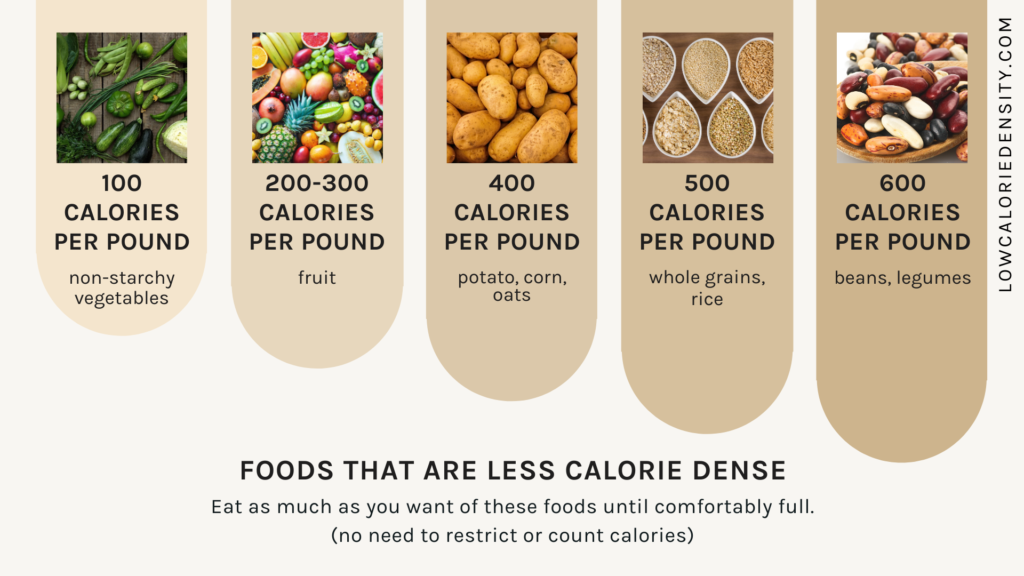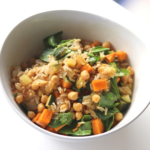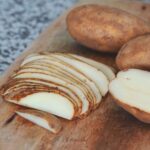Ready to experience the benefits of a low calorie density way of eating? Ready to ditch the calorie counting forever and put your weight loss on autopilot? Here are 14 easy steps to follow. I’ve created a video going through each of the steps that may be helpful for you.
Watch the video:
14 Tips for Success with Low Calorie Density
- Start with the lowest calorie-dense foods first. (refer to the simple chart at the end of this post) Start each meal with a soup, salad, or fruit. This will allow you to fill up with foods that are the lowest in calorie density. For example, if you’re having salad and pasta with broccoli for dinner – eat the salad first – fill yourself up with the lower calorie-dense foods and you don’t have to worry about “over-indulging” in the pasta. Another tip – if you are going to indulge in a higher calorie-dense dessert, have an apple first – this way you will already have filled up on that fiber and water-filled fruit which is only about 240 calories per pound -and it will be less likely for you to go overboard on the dessert you’re about to eat.
- If you have a hard time remembering to eat vegetables daily: Follow the 50/50 plate method for your meals, filling half your plate with non-starchy vegetables like asparagus, carrots, cauliflower, mushrooms, peppers, tomato, and 50% of your plate with minimally processed starches like no-oil sweet potato fries, mashed potatoes, rice, barley or pasta. While it is not necessary to do this for every meal in order to lose weight (as long as you’re sticking with low calorie density foods) it can be a helpful tip for those of you who have a hard time remembering to eat vegetables.
- Ditch the sugar and greatly reduce or eliminate added salt. This includes all sauces or dressings that contain a high level of both of these. Many seemingly healthy sauces and dressings are extremely high in sugar, which we want to stay away from when following low calorie density.
- Eliminate all animal foods (dairy, meat, eggs, fish, seafood). This is a plant-based diet, where we focus on foods that are high in fiber and water.
- Eliminate all higher fat plant foods (i.e., nuts, seeds, avocados, tofu, soy). While these foods are healthy, they are high in calories per bite and can prevent or slow weight loss. Once I had lost the weight and was within my healthy, ideal weight range, I introduced avocado and tofu a few times per week. I still choose not to consume peanut butter because it is 2,665 calories per pound and very addictive for me. (once I start, I want to put it on everything!). NOTE: I always recommend making this way of eating your own – make it work for you. **The overall premise of this diet can be summed up in 8 words:** “Dilute the calories per bite of your food.” …The extent to which you do this is up to you.
- Eliminate foods that contain added oil. NO OIL. Oil is 4,000 calories per pound. No, No, No. Not even olive oil. Not even coconut oil. No oil.
- No dehydrated packaged foods. Eliminate all higher calorie-dense foods including flour products such as bread, bagels, muffins, crackers, dry cereals, cookies, cakes, puffed cereals air-popped popcorn, and dried fruit like raisins and dried cranberries.
- Don’t drink your calories. (especially from juices & sugar-sweetened beverages). Smoothies are the exception because they contain fiber.
- Eat until you’re comfortably full. Don’t starve yourself, don’t stuff yourself. No need to count calories or measure portions.
- Avoid being sedentary. Aim for at least 30 minutes or more of moderate exercise daily (i.e., brisk walking).
- Master your environment. GET the junk food out of your house. This is KEY to avoiding tempting junk foods.
- Avoid Dining Out or ordering takeout. Restaurant food often contains a lot of oil. When you cook at home, you know exactly what is in the food.
- Don’t weigh yourself every day. If you want. to keep track of your weight loss progress, I recommend weighing yourself once per week on the same day. For example, every Monday morning. Write down the number and track it week to week, month to month. Not day-to-day. This prevents obsessing over the number on the scale and will show a more accurate picture of your progress because weight loss is slow and steady and day-to-day weight loss or gain could be due to water weight and/or other processes.
- Study and Learn. Take the time to Research and Learn More! Knowledge is power! Experiment with filling, starchy meals. Get creative. Find inspiration from others who have been eating this way for years and have achieved great health and maintained weight loss. Some people to check out: Dr. Gustavo Tolosa, Dr. Anthony Lim, Dr. John McDougall, Chef AJ, Andrew ‘Spudfit’ Taylor.















